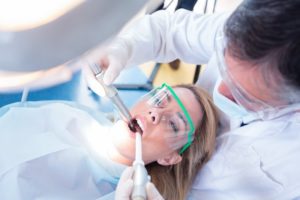
Do you have multiple teeth that are severely worn-down, broken, or missing altogether? If so, your dentist may recommend full mouth reconstruction. This approach combines multiple dental treatments, often making the process more affordable and conservative than performing each of them separately. While each full mouth reconstruction plan is personalized for the patient’s needs, it helps to have an idea of what to expect when recovering. Below, you’ll find some general guidelines for what it’s like to heal from common restorative dental procedures.
Dental Fillings
A popular way to fix mild tooth decay, fillings can typically be completed in a single appointment. You should be able to resume your regular activities afterward. While your mouth may feel sore once the local anesthetic wears off, taking an over-the-counter pain reliever should be enough to combat it.
Crowns & Bridges
These customized dental restorations usually take two appointments: one to prepare the teeth and take impressions, and another to bond the restoration into place. Patients often report some sensitivity for a few days after getting a crown or bridge, but it shouldn’t keep you from going about your day as normal.
Root Canal Therapy
When the nerve-filled pulp in the center of a tooth is severely infected, a dentist must remove it with root canal therapy. After sanitizing the inside of the tooth and replacing the pulp with synthetic material, they seal the tooth with a filling or crown.
Following root canal therapy, many patients experience sensitivity as well as minor swelling and inflammation, but these symptoms should dissipate after a couple of days.
Tooth Extraction
If a tooth is too extensively damaged, the best option for your overall smile may be to extract it. Depending on the severity of your case, it should take about a week after a tooth extraction for your gums to heal over the socket. In terms of comfort, you’ll likely feel back to normal in three to five days.
Dental Implants
There’s a good reason why dental implants are considered the gold standard for replacing missing teeth. After your dentist surgically inserts the implant post into your jaw, it integrates with the bone. At that point, it can support a dental crown, bridge, or denture, depending on how many teeth you need to replace.
Recovering from dental implant surgery is actually fairly similar to healing after a tooth extraction. For the most part, your mouth should feel back to normal within a week. However, it can take three to six months for osseointegration (the process of the implant fusing to the jawbone) to occur.
Follow Your Dentist’s Guidelines for a Smooth Recovery
Since full mouth reconstruction is inherently a personalized process, it’s important that you listen to your dentist’s post-op recommendations and follow them to a tee. That way, you’ll enjoy a fully healed, beautiful smile before you know it!
About the Author
Dr. Nelson Y. Howard is a trusted dentist in Rancho Bernardo, CA with more than three full decades of experience in the dental field. He loves nothing more than restoring patients’ confidence in their smiles; because he is an Accredited Member of the American Academy of Cosmetic Dentistry, you can trust that your results will look flawless! To learn more about how Dr. Howard can help you rebuild your smile with full mouth reconstruction, contact his Rancho Bernardo dental office at 858-451-0550.
